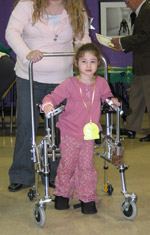IDEA and the Child with Hemiplegia
 The following information is very broad and is intended to give you a general guideline in helping navigate the special educational system. Each child is different; often, each school district, and sometimes each school will have a different interpretation and implementation of the IDEA.
The following information is very broad and is intended to give you a general guideline in helping navigate the special educational system. Each child is different; often, each school district, and sometimes each school will have a different interpretation and implementation of the IDEA.
In 1976, Congress estimated that millions of children with disabilities were not receiving appropriate educational services. Many of these children were excluded from the same classroom experience as their peers. There were also concerns that the disabilities of some children were going undetected and they were not receiving a successful educational experience. Many families were forced, at their own expense, to go outside of the public school system to find educational resources for their child.
In 2004, Congress approved the Individuals with Disabilities Education Improvement Act (IDEA 2004).
The U. S. Department of Education, Office of Special Education Programs’ IDEA website
General Overview of Special Education (Wisconsin)
Consent
Parental Consent for Evaluation – The school must obtain informed consent from the parent before conducting the initial evaluation to determine if a child qualifies with a disability.
Parental Consent for Services – The school must obtain informed consent from the parent before providing special education and related services to the child.
Parental Consent for Reevaluation – The school must obtain informed consent from the parent before conducting the any reevaluation of a child with a disability.
Initial Evaluations
 The school must conduct a full and individual initial evaluation before they provide special education and related services. Either the school or the parent may request the initial evaluation to determine if the child has a disability.
The school must conduct a full and individual initial evaluation before they provide special education and related services. Either the school or the parent may request the initial evaluation to determine if the child has a disability.
Initial Evaluation Procedures
- Must be conducted with 60 days of receiving parental consent for evaluation
- Must be within the State’s timeframe, if such exists
- Must determine if the child has a disability and also determine the educational needs of the child
- Screening of the child by a teacher or specialist to determine instructional strategies is not considered to be an evaluation for eligibility for special education
Reevaluations
- Must be conducted if a school determines that the educational or related needs, including improved academic achievement and functional performance, of the child warrant a reevaluation or
- Must be conducted if the child’s parent or teacher requests a reevaluation
- May not occur more than once a year, unless the parent and school agree otherwise
- Must occur at least once every three years, unless the parent and school agree that a reevaluation is unnecessary
Evaluation Procedures
Additional Requirements for Evaluations and Reevaluations
Determination of Eligibility
 Upon completion of the administration of assessments and other evaluation measure a group of qualified professionals and the parent of the child determines whether the child is a child with a disability. the school must provide a copy of the evaluation report and the documentation of determination of eligibility at no cost to the parent.
Upon completion of the administration of assessments and other evaluation measure a group of qualified professionals and the parent of the child determines whether the child is a child with a disability. the school must provide a copy of the evaluation report and the documentation of determination of eligibility at no cost to the parent.
Definition of a Child with a Disability
A “child with a disability” means a child who has been evaluated and found to have one or more of the following and who, by reason thereof needs special education and related services:
- mental retardation
- hearing impairment, including deafness
- speech or language impairment
- visual impairment
- serious emotional disturbance
- orthopedic impairment
- autism
- traumatic brain injury
- other health impairment (OHI)
- specific learning disability
- deaf-blindness
- multiple disabilities
Note that if the child needs only a related service, then the child is not considered a “child with a disability”.
Children with Hemiplegia
The most common conditions that may qualify a child with hemiplegia as a child who has a disability are listed below. Consult the original statue for additional conditions and details.
- Orthopedic Impairment means a severe orthopedic impairment that adversely affects a child’s educational performance. The term includes impairments caused by a congenital anomaly, impairments caused by disease (e.g., poliomyelitis, bone tuberculosis), and impairments from other causes (e.g., cerebral palsy, amputations, and fractures or burns that cause contractures).
- Other Health Impairment means having limited strength, vitality, or alertness, including a heightened alertness to environmental stimuli, that results in limited alertness with respect to the educational environment, that is due to chronic or acute health problems such as asthma, attention deficit disorder or attention deficit hyperactivity disorder, epilepsy, a heart condition, sickle cell anemia (this is only a portion of the OHI conditions – consult the IDEA statutes for additional conditions). The health impairment adversely affects a child’s educational performance.
- Specific learning disability means a disorder in one or more of the basic psychological processes involved in understanding or in using language, spoken or written, that may manifest itself in the imperfect ability to listen, think, speak, read, write, spell, or to do mathematical calculations, including conditions such as perceptual disabilities, brain injury, minimal brain dysfunction, dyslexia, and developmental aphasia. Specific learning disability does not include learning problems that are primarily the result of visual, hearing, or motor disabilities, of mental retardation, of emotional disturbance, or of environmental, cultural, or economic disadvantage.
- Speech or language impairment means a communication disorder, such as stuttering, impaired articulation, a language impairment, or a voice impairment, that adversely affects a child’s educational performance.
- Mental Retardation means significantly subaverage general intellectual functioning, existing concurrently with deficits in adaptive behavior and manifested during the developmental period, that adversely affects a child’s educational performance.
- Traumatic brain injury means an acquired injury to the brain caused by an external physical force, resulting in total or partial functional disability or psychosocial impairment, or both, that adversely affects a child’s educational performance. Traumatic brain injury does not apply to brain injuries that are congenital or degenerative, or to brain injuries induced by birth trauma.
- Visual impairment including blindness means an impairment in vision that, even with correction, adversely affects a child’s educational performance. The term includes both partial sight and blindness.







